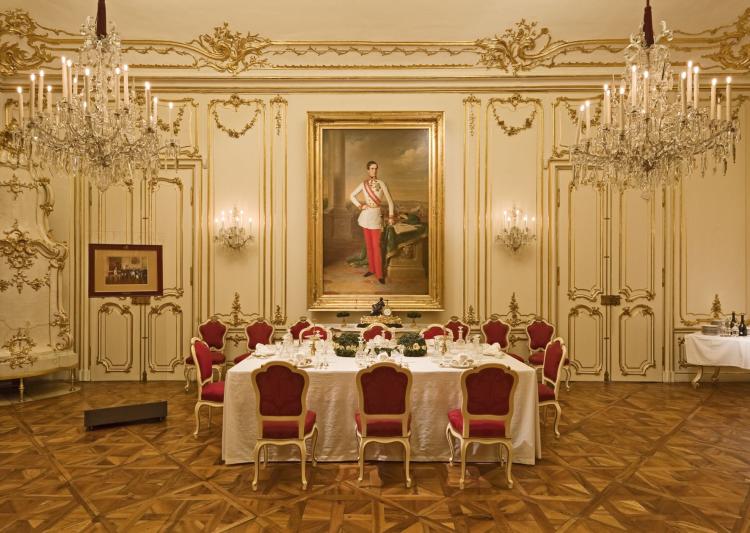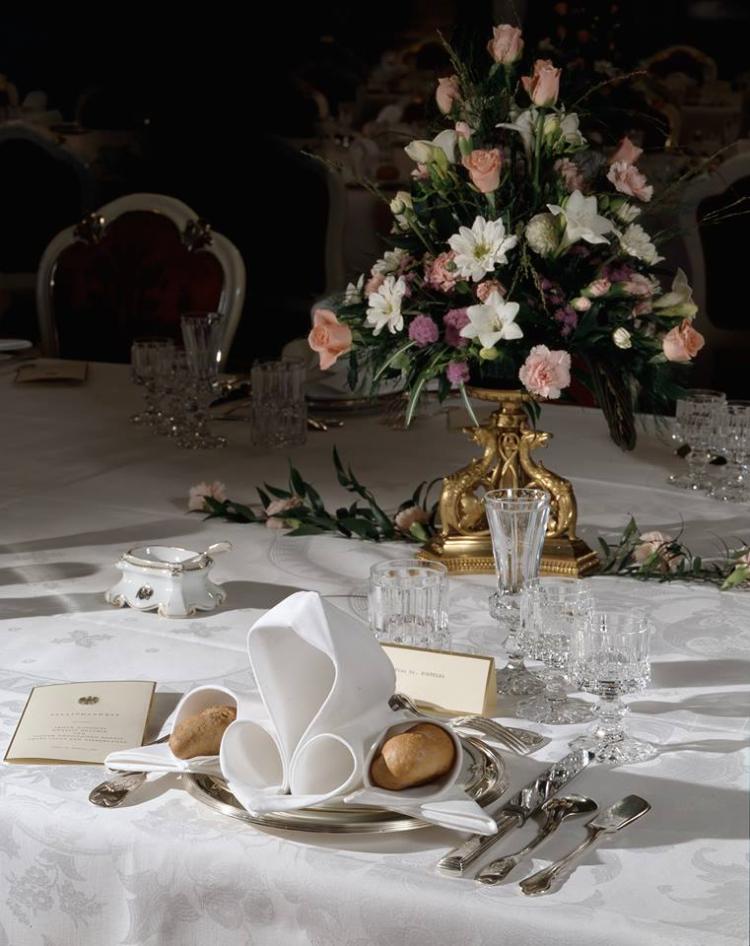IMPERIAL DINNERS IN VIENNA: Invited to dinner by Emperor Franz Joseph
One might think that the high-rank guests could eat as much as they wished during an imperial dinner, however, they often had to leave the table with an empty stomach because Emperor Franz Joseph ate very quickly and Empress Elisabeth hardly ate anything. Since nobody may eat after the Emperor left the table because it would have been an offence against the etiquette, the family members and the highest-rank guests often had to finish their dinner at Sacher Hotel while the remained food was sold by the servants. Although Sisi usually refused to eat much, she loved eating sometimes but never at formal dinners.
Marie Antoinette Room - the family dining room at Schönbrunn Palace - The painting in the middle shows Franz Joseph at the age of 20. The Emperor sat in front of it, the Empress opposite him. © Schloß Schönbrunn Kultur- und Betriebsges.m.b.H./Alexander Eugen Koller

During Franz Joseph’s time the former room of Maria Theresa’s daughter, Marie Antoinette, who was beheaded during the French Revolution, served as a family dining room. The table now is laid for a family dinner with Viennese porcelain, Viennese court silverware and crystal glasses. When the imperial family dined here, the occasion was less formal than at court dinners, which were strictly regulated by the etiquette. The Emperor decided on the seating plan himself and conversation was permitted across the table, whereas at court dinners one could only converse with one's immediate neighbour in an undertone.
On official occasions French dishes were served, while at family dinners Viennese cuisine and simpler dishes were preferred. These included Wiener schnitzel, beef goulash, beef with onions, steamed dumplings or 'Kaiserschmarren' (meaning literally 'the emperor's nonsense', a sweet shredded omelette made with raisins and served with fruit compote). (Information from the book of Maria Wiesmüller, see below: Work Cited.)
The imperial dining-room in Hofburgban © Schloß Schönbrunn Kultur- und Betriebsges.m.b.H. / Edgar Knaack

The imperial dining-room in Hofburg gives us a glimpse into the time of the Austro-Hungarian Monarchy. You can see a table set for a formal dinner during Franz Joseph’s time. The Emperor held state banquets, family dinners and military ones. Official dinners, which were started at six o’clock, were held three times a week. About thirty people, mostly high-rank noble men were invited to them. Franz Joseph appeared and took his place at the centre only after all the guest had arrived, but one had to be there on time.
“As a rule seven to thirteen courses were served at court dinners, and at official meals French cuisine was preferred. Service was prompt and discreet, as there was one lackey for every two people and all the guests were served at once. Dinners usually lasted 40 to 45 minutes and one only conversed with one’s immediate neighbours.” (Source see: Works Cited below the article)
Imperial napkin. Imperial Silver Collection, Hofburg © Bundesmobilienverwaltung

Every Sunday the whole imperial family, that is, every Habsburg in Vienna was invited to dinner. At these occasions, the participation was obligatory. “The only excuses accepted by Franz Joseph for non-attendance were illness or official duties.” (Source see: Works Cited below the article) However, one had to inform the head of the court household about the absence in advance. According to the Habsburg family members, these dinners were very good, informal and lively occasions.
Last but not least, let us have some words about the table linen and the silver tableware. The napkins were folded traditionally. The shape of the imperial table cloths were round or square (between 120 and 420 centimetre), and rectangular (between 190 and 200 centimetre). The imperial napkin was 90 x 90 centimetre and the dessert napkin was 35 x 35 centimetre, furthermore, there were simple napkins used by the Court employees.
Silver tableware. Imperial Silver Collection, Hofburg © Schloß Schönbrunn Kultur- und Betriebsges.m.b.H. / Willfried Gredler

As regards the the silver tableware, originally they were kept in the Silver Room and guarded continuously. Not only the room but also the routes to it used by the staff were supervised as well as the exact pieces taken out by the servants for the meal. The food was taken in heated wheeled carts so it was still hot when served. In the 19th century, the Silver Room was united by the Table Room, in which the porcelains, cutleries, glasses and other objects needed to the serving were kept. “After the collapse of the Habsburg monarchy (1918) the stock of silver (...) became the property of the Republic of Austria” (Source see: Works Cited below the article), and, of course, the imperial household was dissolved. The pieces which were not sold by the Republic were transferred back to the Former Silver and Table Room and have been exhibited, so one can see them now as well.
Visit the exhibition of the Imperial Silver Collection of Hofburg. Click the photo below.
Visit Empress Elisabeth on Facebook.
Magyarul: CSÁSZÁRI VACSORÁK
Works cited:Ingrid Haslinger - Olivia Lichtscheidl - Michael Wohlfart: The Residence of Empress Elisabeth. Imperial Apartments, Sisi Museum, Imperial Silver Collection (quotes from Page 68-86)Maria Wiesmüller. Sissi's favourite recipes. Kompass-Karten, 2011



